
We look at the 10-minute bar chart to understand the market gyrations of the week. The SPX has formed three trading ranges and price is set to test the bottom of the 'middle' trading range starting Monday. Today's price action punctuated the week with a negative RSI and a falling PMO below the zero line.
(We will cover the new USO BUY signal in the section on Oil.)
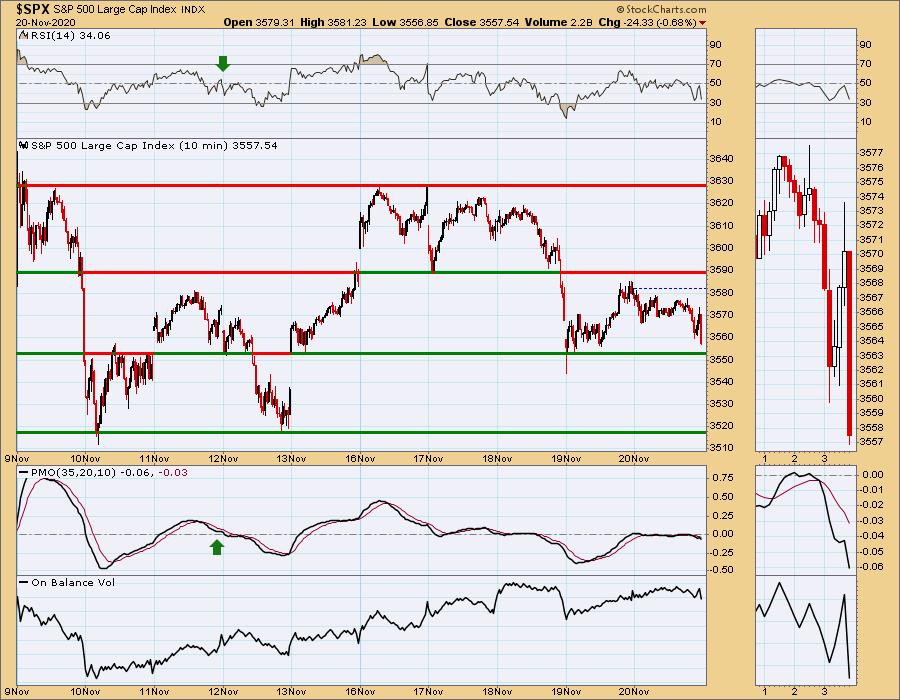
The DecisionPoint Alert Weekly Wrap presents an end-of-week assessment of the trend and condition of the Stock Market, the U.S. Dollar, Gold, Crude Oil, and Bonds. The DecisionPoint Alert daily report (Monday through Thursday) is abbreviated and gives updates on the Weekly Wrap assessments.
Watch the latest episode of DecisionPoint on StockCharts TV's YouTube channel here!
MAJOR MARKET INDEXES
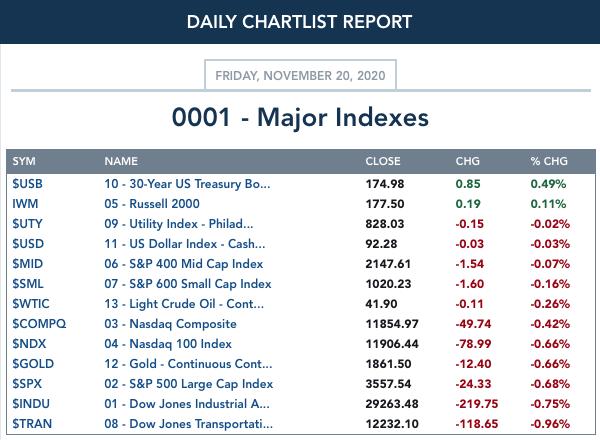
SECTORS
Each S&P 500 Index component stock is assigned to one, and only one, of 11 major sectors. This is a snapshot of the Intermediate-Term (Silver Cross) and Long-Term (Golden Cross) Trend Model signal status for those sectors.


CLICK HERE for Carl's annotated Sector charts.
THE MARKET (S&P 500)
IT Trend Model: BUY as of 5/8/2020
LT Trend Model: BUY as of 6/8/2020
SPY Daily Chart: With options expiration this week, volatility was low, as expected. The RSI is positive but declining as price consolidates around the support/resistance line at the September top. The PMO is decelerating. The OBV declining tops confirm this very short-term declining trend.
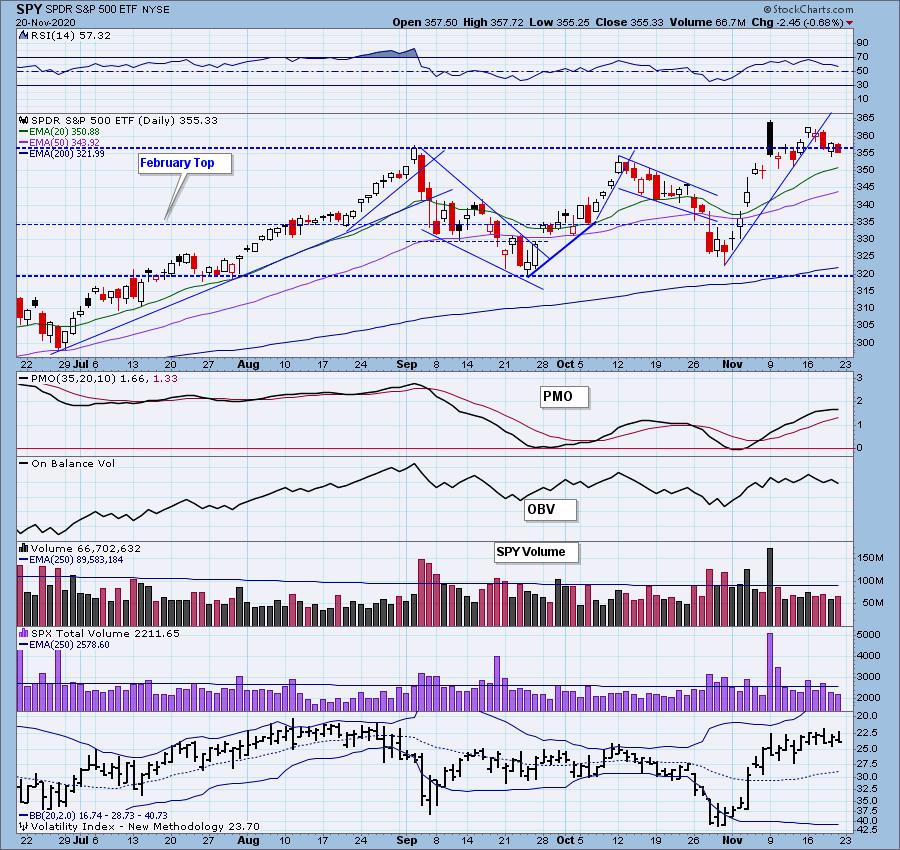
It appeared we might break out of this trading range and rally further. Unfortunately, we had a buying exhaustion line up and price is now back within the range.

SPY Weekly Chart: The weekly chart doesn't look that bearish. The broadening top is a problem and we are at the top of the pattern positioned basically at the top of a cliff. However, the RSI remains positive and the PMO has bottomed above its signal line.
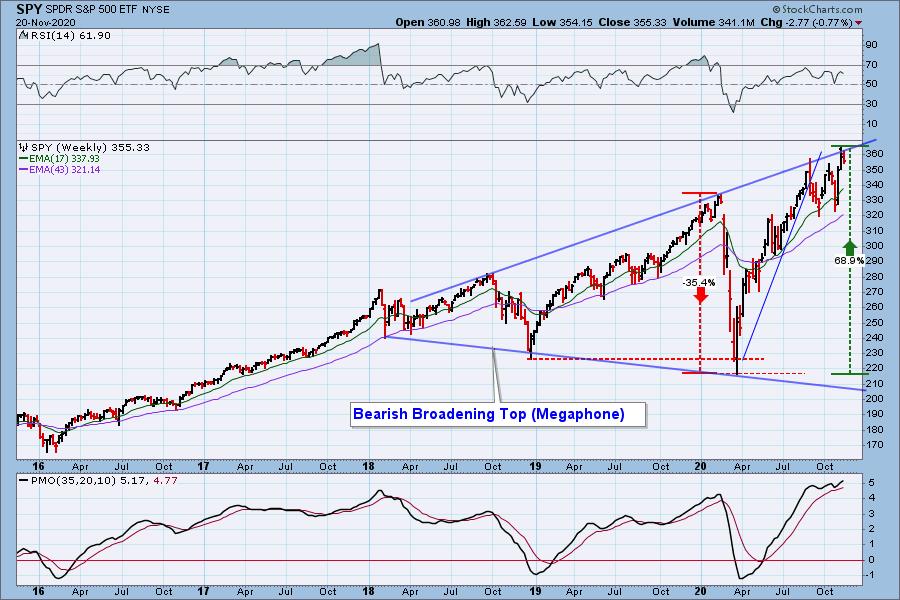
Participation: The following chart uses different methodologies for objectively showing the depth and trend of participation for intermediate- and long-term time frames.
- The Silver Cross Index (SCI) shows the percentage of SPX stocks on IT Trend Model BUY signals (20-EMA > 50-EMA).
- The Golden Cross Index (GCI) shows the percentage of SPX stocks on LT Trend Model BUY signals (50-EMA > 200-EMA).
- The Bullish Percent Index (BPI) shows the percentage of SPX stocks on Point & Figure BUY signals.
The BPI finally had a negative crossover today. The SCI and GCI are rising, but decelerating in overbought territory.
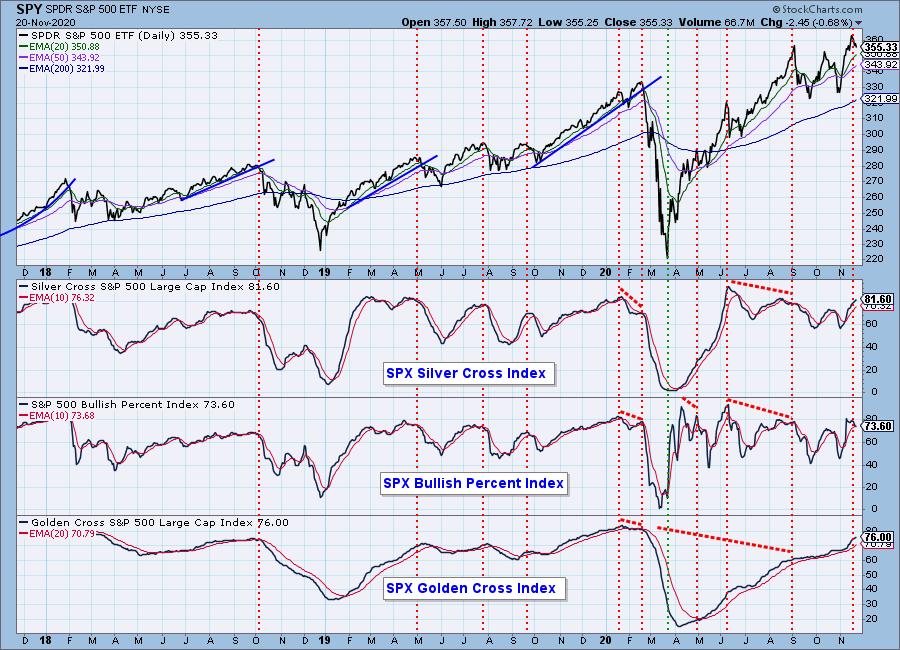
These indicators remained overbought all week, but they are now beginning to deteriorate.

Climactic Market Indicators: No climactic readings, but you can see we had a buying exhaustion line up on Monday after the big rally.
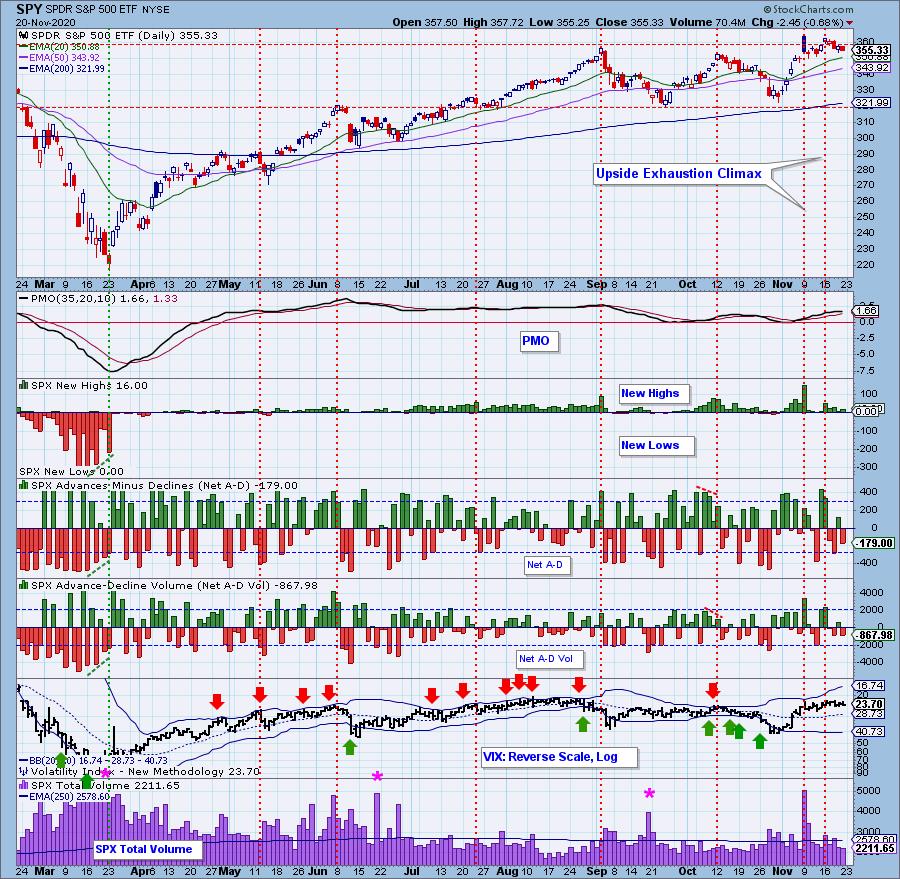
NYSE Up/Down and Down/Up volume ratios can be also be used as climax detectors. We use the 9:1 ratio suggested by the late Dr. Martin Zweig in his book, Winning on Wall Street. These climaxes happen less frequently than those on the chart above, and they can be used to clarify a particular event. We have an NYSE and S&P 500 version of the ratios, and normally they will only be published when there is a climax ratio.
We didn't see confirming readings on the NYSE Volume Ratios for Monday.
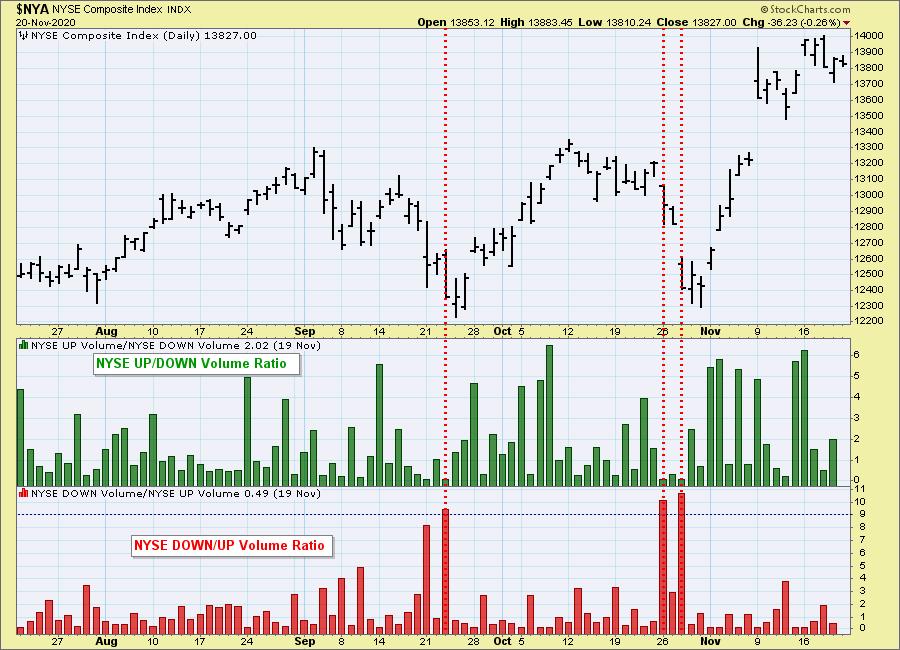
The S&P 500 version can get different results than the NYSE version because: (a) there are only 500 stocks versus a few thousand; and (b) those 500 stocks are all large-cap stocks that tend to move with more uniformity.
However, we did see a confirming climactic reading on the SPY Up Volume/Down Volume ratio.
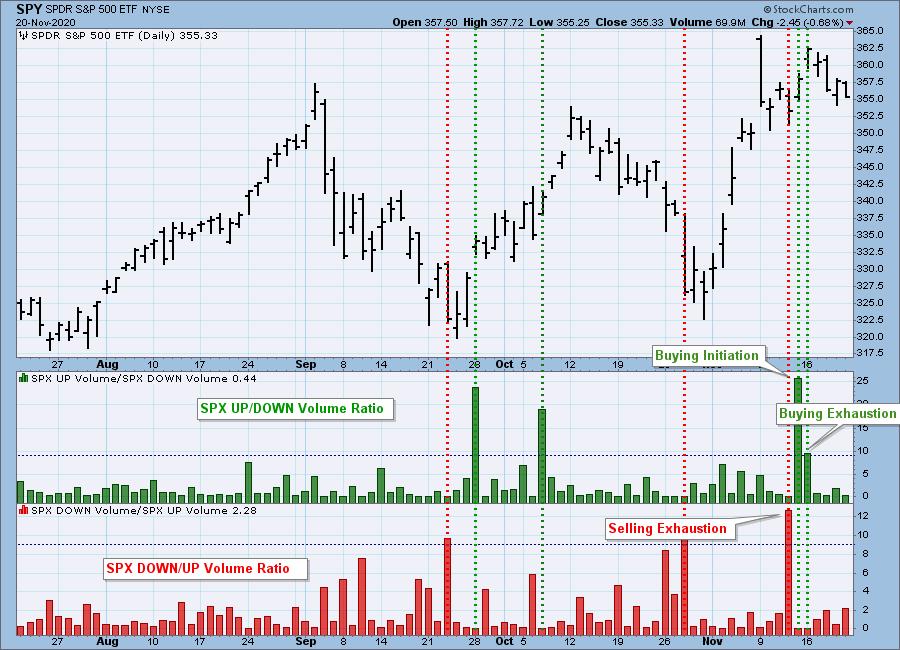
Short-Term Market Indicators: The short-term market trend is NEUTRAL and the condition is OVERBOUGHT. The negative divergences relative to the October and November price tops are not profound, but they're there.
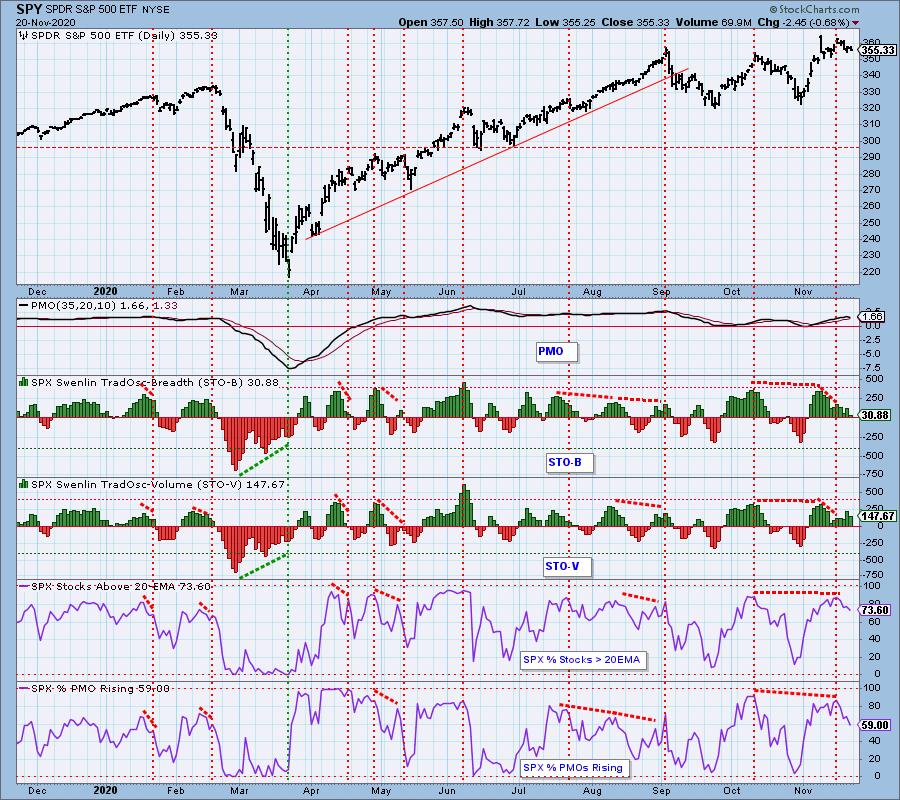
Intermediate-Term Market Indicators: The intermediate-term market trend is UP and the condition is modestly OVERBOUGHT. The market bias is BULLISH. Nevertheless, we also have negative divergences across all indicators on this chart. The ITVM finally turned down today and that gave us an "official" top to complete the negative divergence on that particular indicator. The other negative divergences were already in place.
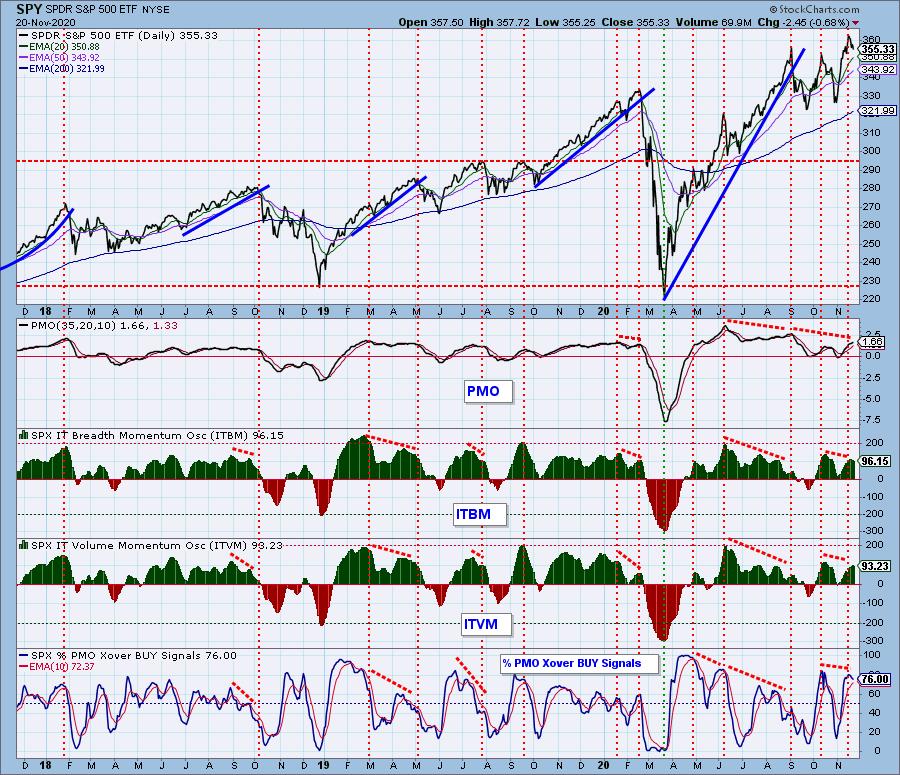
CONCLUSION:
Next week is a holiday week, so our primary expectation is for low volatility and low volume. The negative divergences continue to plague the indicator charts and that makes the market very vulnerable to a decline. For now, given holiday trading and a continued bullish bias, it isn't likely we will see this weakness play out next week in a deep decline, but we have the "Sword of Damocles" hanging over the market with these divergences. Tighter stops should be a considered, especially if you will be away from the market next week.
Have you subscribed the DecisionPoint Diamonds yet? DP does the work for you by providing handpicked stocks/ETFs from exclusive DP scans! Add it with a discount! Contact support@decisionpoint.com for more information!
INTEREST RATES
This chart is included so we can monitor rate inversions. In normal circumstances the longer money is borrowed the higher the interest rate that must be paid. When rates are inverted, the reverse is true.
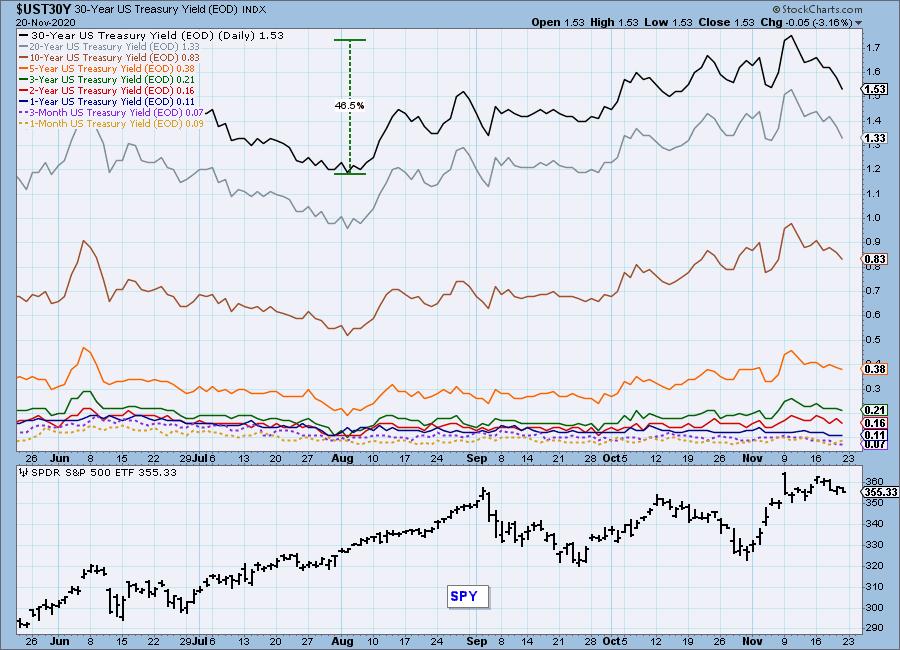
DOLLAR (UUP)
IT Trend Model: NEUTRAL as of 5/28/2020
LT Trend Model: SELL as of 7/10/2020
UUP Daily Chart: The Dollar spent the week testing support at $24.75. The RSI is negative and the PMO is still declining so we're not expecting a big rally next week.

UUP Weekly Chart: The PMO topped below its signal line on the weekly chart and the RSI remains negative. UUP is at a 'decision point'. The next support level is around $24. If UUP can reverse here it would set up a nice double-bottom, but as noted, it needs to hold support first.
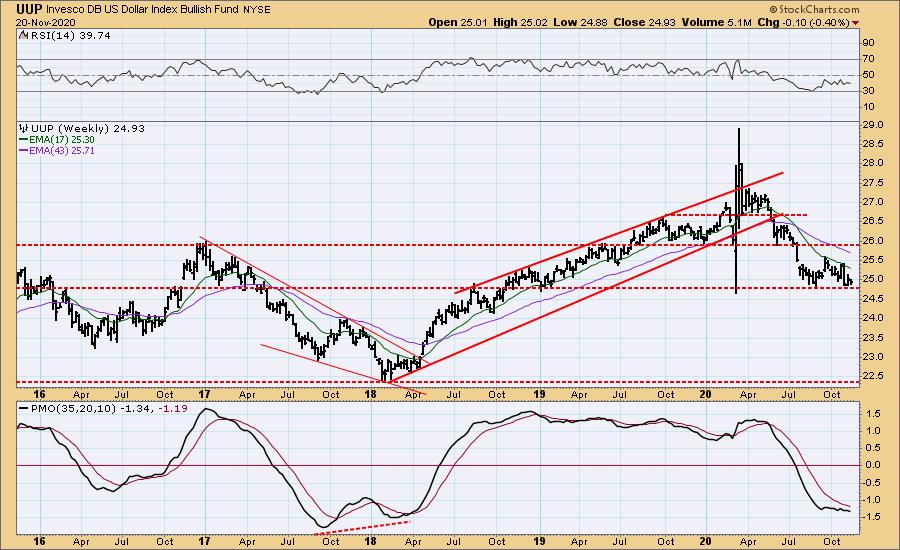
GOLD
IT Trend Model: NEUTRAL as of 10/14/2020
LT Trend Model: BUY as of 1/8/2019
GOLD Daily Chart: We've removed the falling wedge from the chart. Price was reaching the apex and not breaking out. Soon if priced moved sideways, it could 'break out' of the pattern without a rally. That is a stale chart pattern. Right now we are looking at a trading channel. Price is holding the long-term rising trend, but is stuck under the 20/50-EMAs. The PMO is declining and the RSI is negative. Discounts on PHYS remain high. Remember discounts and premiums are a measure of sentiment, so bearish sentiment (discounts) is bullish for Gold prices. Look for more sideways price action.
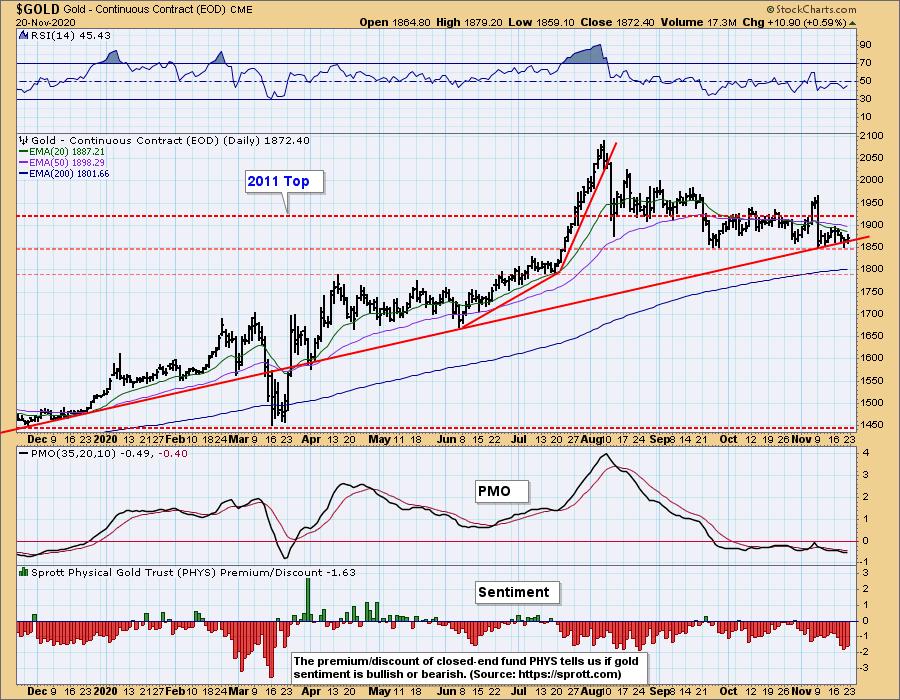
GOLD Weekly Chart: You can still make the case for the bullish falling wedge on the weekly chart if you connect the two cardinal tops. However, the weekly PMO is declining quickly out of overbought territory and the RSI is retreating toward negative territory. Best case, Gold holds support at the September low and worst case, it tests $1800.

GOLD MINERS Golden and Silver Cross Indexes: Difficult week for Miners, but they did end on a positive note, bouncing after closing below the 200-EMA for the first time since price came out of the bear market. The RSI is negative and the PMO is falling. Looking under the hood, %Stocks > 20/50/200-EMAs are oversold. The BPI has flattened which is positive. The SCI is beginning to bottom and we generally see higher prices on those lows. The GCI at 100% tells us that all of the Mining stocks have their 50-EMA above the 200-EMA. That is clearly an overbought reading but could also indicate underlying strength that will push prices higher.
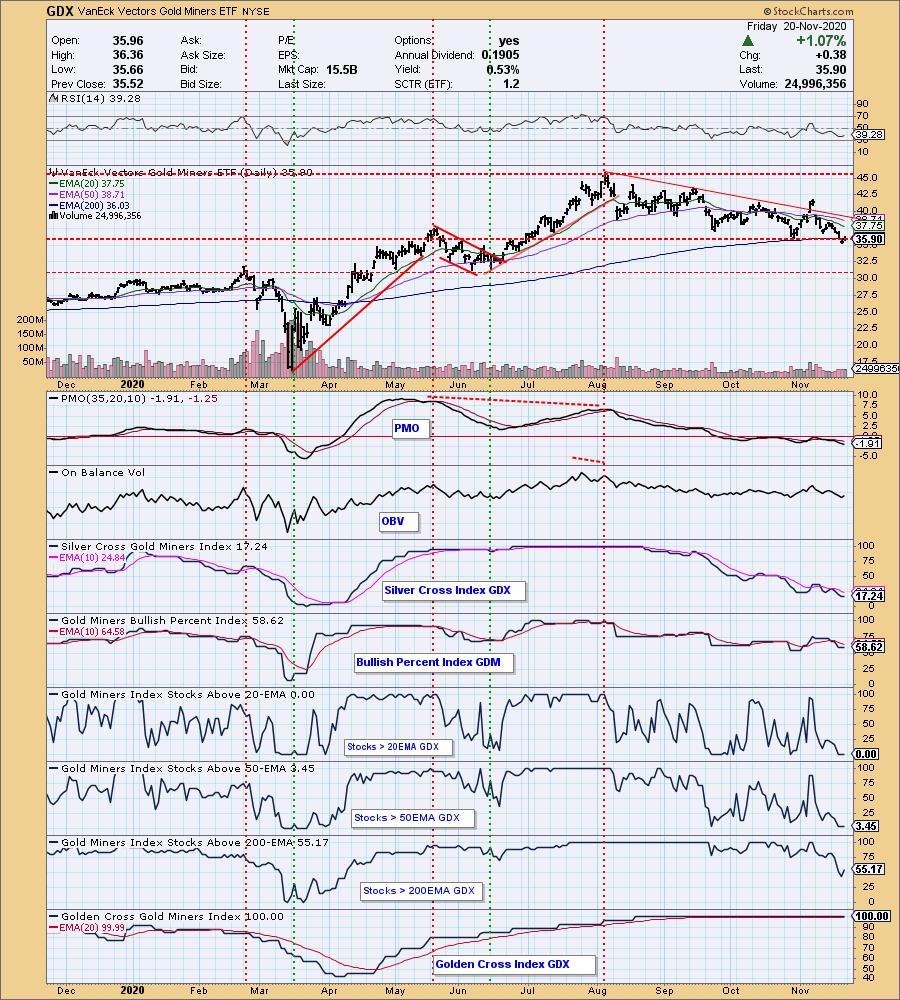
CRUDE OIL (USO)
IT Trend Model: BUY as of 11/20/2020
LT Trend Model: SELL as of 2/3/2020
USO Daily Chart: The IT Trend Model BUY signal was triggered as the 20-EMA crossed above the 50-EMA. At this time price is being held up at the $29.50 resistance level. More than likely we are looking at a 'pause' as Oil digests the strong rally off the October low. The RSI is positive and the PMO is above zero and rising, USO will likely breakout and test $31.

USO/$WTIC Weekly Chart: That overhead resistance level is very strong. Not only is the August high a problem, so is the 17-week EMA. Neither USO or $WTIC have overcome the August high. The RSI is still negative, but the PMO is rising. Momentum certainly suggests a breakout is nearing.
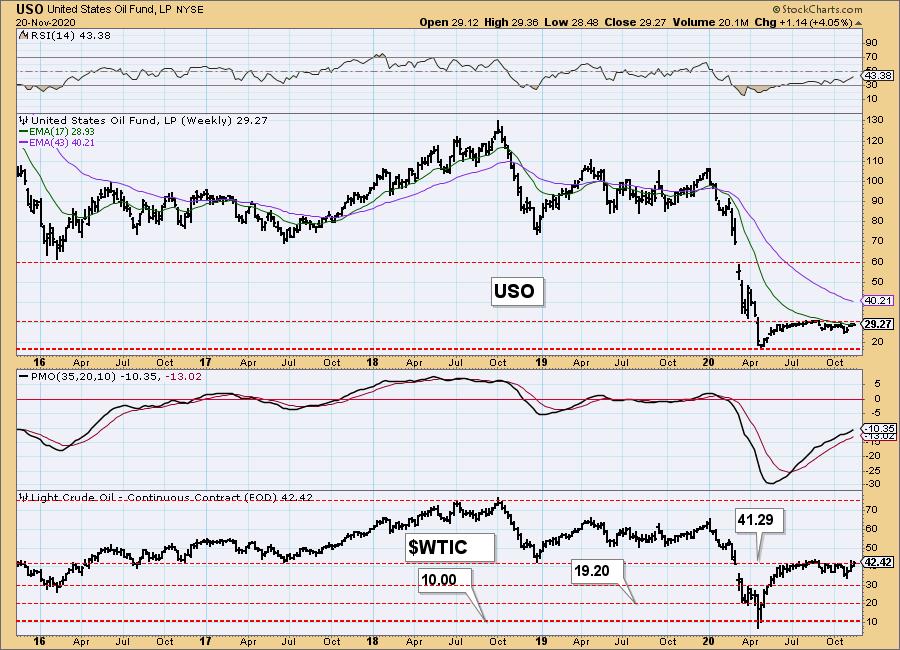
BONDS (TLT)
IT Trend Model: NEUTRAL as of 8/27/2020
LT Trend Model: BUY as of 1/2/2019
TLT Daily Chart: With yields falling, TLT was able to rally strongly this week. Price is now back above the 50-EMA. Price wasn't able to clear it back in September, but this time around, the RSI is in well within positive territory. The PMO is also rising on a BUY signal.
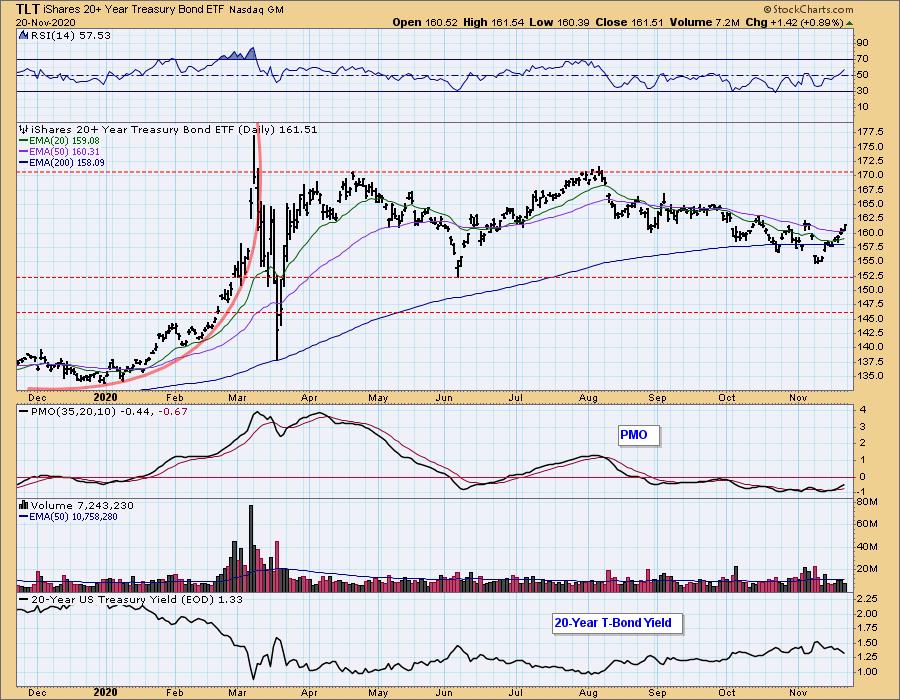
TLT Weekly Chart: The declining trend is still intact but price did manage to close above the 17-week EMA. The PMO is decelerating slightly and the RSI has reentered positive territory. Our outlook is bullish on Bonds.
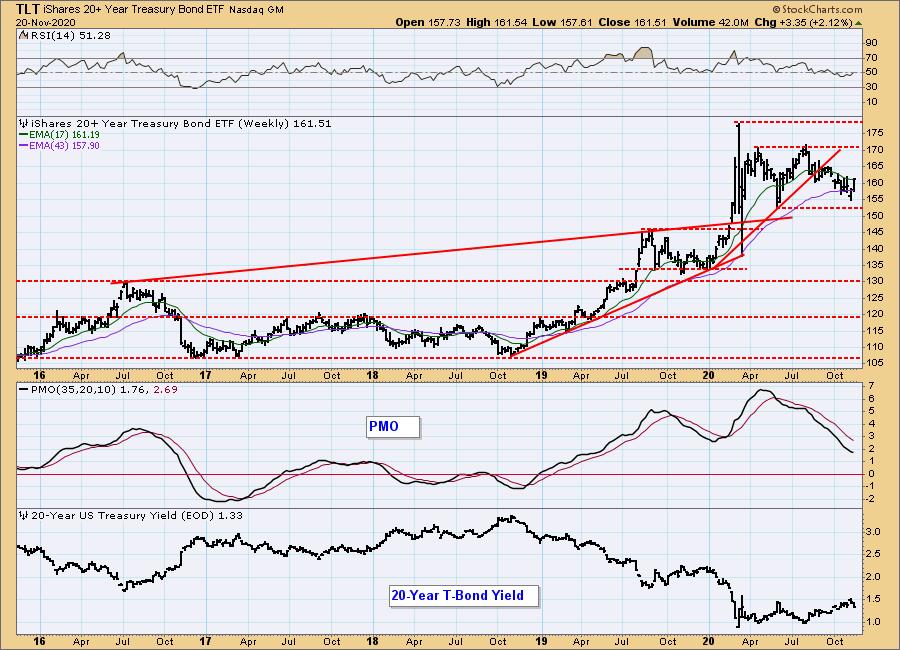
Technical Analysis is a windsock, not a crystal ball.
-- Carl Swenlin and Erin Swenlin
___________
Our job is not to see the future, it is to see the present very clearly.
-- Jawad Mian, stray-reflections.com
Disclaimer: This blog is for educational purposes only and should not be construed as financial advice. The ideas and strategies should never be used without first assessing your own personal and financial situation, or without consulting a financial professional. Any opinions expressed herein are solely those of the author, and do not in any way represent the views or opinions of any other person or entity.
NOTE: The signal status reported herein is based upon mechanical trading model signals, specifically, the DecisionPoint Trend Model. They define the implied bias of the price index based upon moving average relationships, but they do not necessarily call for a specific action. They are information flags that should prompt chart review. Further, they do not call for continuous buying or selling during the life of the signal. For example, a BUY signal will probably (but not necessarily) return the best results if action is taken soon after the signal is generated. Additional opportunities for buying may be found as price zigzags higher, but the trader must look for optimum entry points. Conversely, exit points to preserve gains (or minimize losses) may be evident before the model mechanically closes the signal.
Helpful DecisionPoint Links:
DecisionPoint Alert Chart List
DecisionPoint Golden Cross/Silver Cross Index Chart List
DecisionPoint Sector Chart List
Price Momentum Oscillator (PMO)
Swenlin Trading Oscillators (STO-B and STO-V)
